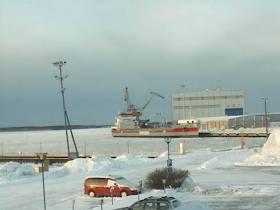Displaying items by tag: Port of Kokkola, Finland
Another Corrib Cargoship Concentrates on Boliden Tara Mines Exports to Frozen Finnish Gulf Port
#Ports&Shipping - A Corrib Shipping cargoship loaded concentrates from Boliden Tara Mines facility in Dublin Port late last year, arrived at a Finnish port this first week of 2018 and where the sea is currently frozen over, writes Jehan Ashmore.
The cargoship Ziltborg which last year became the fifth ship of Corrib Shipping fleet, sails as part of Royal Wagenborg, a Dutch operator with more than 170 vessels. They also act as chartering agents for the Irish based ship management group located in Dundrum, Co. Dublin. The vessel previously named Viechtdiep was drydocked to emerge as the Dutch flagged Ziltborg and under the new livery of Wagenborg.
Trains transport the concentates to Dublin Port from Boliden's Co .Meath mine (Europe's largest for zinc) which since 1977 has extracted 85m tonnes of ore. At the port the concentrates are transferred from wagons to a conveyor belt that leads to a jetty within Alexandra Basin. At the bulk north jetty a loading shoot was lowered into the Ziltborg's cargohold.
On completion of loading the 7,200dwt Ziltborg's open hatch, full box and double skinned hull, the single decker cargoship departed Dublin on 28 December. It is at this facility where a fleetmate Cathma called in November and likewise of Ziltborg, involved a voyage to Kokkola. The western Finnish port town on the frozen icy Gulf of Bothnia, located in the Central Ostrobothnia region has a population of over 47,000.
The Gulf of Bothnia, that separates west Finland and east Sweden forms the northernmost arm of the Baltic Sea. The Gulf which is shallower in depth and being almost freshwater becomes frozen, as such traffic restrictions for icebreaker assistance are typically in force for all the gulf from later this month to the end of April.
The 118m Ziltborg which has an Ice Class 1A notation for operating in Finnish and Swedish waters, had arrived to Kokkola on Thursday of this week. As of today, weather conditions report temperatures of -4° and are to drop further overnight to -6° (feeling like -9°).
For a link to a livestream of the Ziltborg berthed in the frozen icy waters click here.























